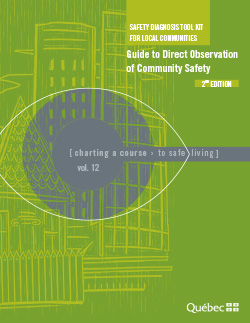Safety Diagnosis Tool Kit for Local Communities: Guide to Direct Observation of Community Safety – 2nd edition
In making safety diagnoses, it is sometimes useful to estimate or quantify certain behaviours or environmental features through direct observation of life settings. This observation method makes it possible to gather and analyze information on a series of problem safety situations related to the characteristics or behaviour of individuals (incivility) or to certain characteristics of the physical environment (disorder). Generally speaking, it requires the use of an observation log for entering information on the safety situations under study.
Even though it is difficult to foresee all of the problem safety situations that can arise in life settings, we have singled out a certain number on the basis of the scientific literature. All of these situations10 are included in the observation log proposed in Appendix 4:
- Aggressive, intimidating or annoying behaviour by certain individuals.
- Congregation of young people or adults who engage in annoying behaviour (disturbing the peace, loitering, etc.).
- Activities related to the sale or use of drugs and the repercussions of these activities on the life setting where they occur.
- Prostitution activities and their repercussions on the life setting where they occur.
- Lack of cleanliness in certain areas (presence of litter, syringes, pieces of glass, etc.).
- Graffiti on buildings or equipment.
- Other signs of vandalism on buildings or equipment (bus shelters, benches, play equipment, telephone booths, streetlights, etc.).
- Other signs of vandalism in outdoor public spaces (on trees, landscaping, etc.).
- Abandoned or dilapidated buildings.
- Poor or defective lighting (broken or out-of-service lights) in public places.


